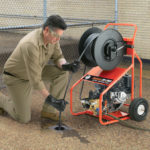By: Dave Dunbar
Drain cleaning and inspection questions are commonly asked in the plumbing industry so professionals can learn and grow. Maintaining drains and navigating drain cleaning tools can sometimes feel challenging. In this blog, we address frequently asked questions, shed light on common issues, and provide insights into proactive inspection practices.
- What are plumbing contractors’ most common issues or challenges regarding drain cleaning and inspection?
Drain cleaning and pipe inspection can be some of the more challenging aspects of a plumber’s job. First, it can be very physically demanding. Although much lighter and safer than the drain-cleaning tools that previous generations wrestled with, modern drain-cleaning equipment and machines are still relatively heavy and require patience and caution to operate successfully. Second, when cleaning a clogged drain or sewer pipe, the drain cleaning professional works in a dangerous and contaminated workplace, where situational awareness and personal hygiene measures are absolutely required.
Third, a sewer or drain clog can have many different causes, and the contractor must be open to possible causes to avoid misdiagnosing the problem.
For example, a backed-up lateral drain line might be caused by roots, a collapsed pipe, a belly or dip in the pipe, a buildup of non-flushable paper products, sludge, and grease, or simply because he had 12 people over for the weekend and his system was overwhelmed! It’s important that the contractor keeps an open mind when diagnosing the problem and has access to several different types of drain cleaning machines to ensure they will succeed. Having a snake-style machine, a high-pressure water jetter, a flexible shaft device, and a pipe inspection system are all considered necessary equipment in today’s industry. In addition, as in most other fields, there is no substitute for experience. A rookie can learn the basics in all the above machines in a single day, but the steady growth curve continues to rise for years after their first experience.
- What emerging technologies or methods are changing the landscape of drain cleaning and inspection in the plumbing industry?
As was mentioned above, modern drain cleaner professionals tend to come prepared to use drain snake-style machines, high-pressure water jetters, flexible shaft devices, and pipe inspection camera systems. All of these machines have their specialty, and having access to many different types of technology can have a synergetic effect on the drain cleaner’s efforts. When high-pressure water jetters were first developed in the 1980s, some plumbers thought they would replace snake-style machines. However, it was found that jetters have their place in clearing pipes of grease and soft stoppages but are inferior to snake-style machines when dealing with hard stoppages such as roots and clogs of paper products. Similarly, when flexible shaft devices gained popularity about five years ago, some professionals thought they would quickly replace snakes and jetters. Again, the present consensus is that they are simply another tool in the professional’s arsenal. Plumbers and drain cleaners tend to do better when they approach each job flexibly, focusing on the job’s general purpose and the big picture and using the most appropriate tool for the situation.
For example, it can be more effective to poke a hole in a grease-clogged pipe with a drain snake-style machine and then follow up with a jetter or flexible shaft device to finish the job. If you begin the job with the high-pressure water jetter, you might find that water backs up to your access pipe before you can work your way through the obstruction. Similarly, when dealing with a stubborn root incursion, most professionals would prefer to start the process with a snake-style machine and then do the cleanup with the flexible shaft or jetter device. Flexible shafts are very good at cleaning pipes that are not severely blocked. However, it makes sense to poke a hole in the obstruction with a snake first before going in with the high-speed, low-torque flexible shaft device. No matter what tools are used to open the drain, professionals tend to send their pipe inspection camera down the line afterward. This allows them to check their work and look for other defects and issues that could cause a problem for the customer in the future. By finishing each job with a camera inspection, you ensure that you’re doing the best possible job for the customer and that you are not leaving anything on the table for yourself.
- How have customer expectations regarding drain cleaning and inspection evolved in recent years, and how can plumbing contractors adapt to meet these expectations?
During Covid, customer expectations regarding cleanliness, hygiene, and safety skyrocketed. The use of gloves, booties, and masks became mandatory, and in most areas, these conventions continue. Customers in today’s world expect the contractor to be polite, neat, clean, and sanitary. In addition, thirty years of seeing pipe inspection camera recordings have led this generation to expect no less. Home and business owners now want to see the problem and have their questions answered before writing a check. Plumbers and drain cleaner professionals have easily adapted to these new expectations and, as described above, have found ways to use them to build business. Because of changes in drain cleaning equipment and rising customer expectations, today’s drain cleaning contractor is doing a far superior job than previous generations.
Drain cleaning professionals can rest assured that they are providing a critical service because life as we know it can’t exist without flushing toilets. Plus, they are helping to shore up our sewage treatment infrastructure by cleaning and repairing defective pipes. Finally, their drain cleaning tools can help them earn a good living during both boom times and recessions because a clogged drain is always happening!
For more information or to speak with our experts, call the Drain Brains at 800-245-6200.



